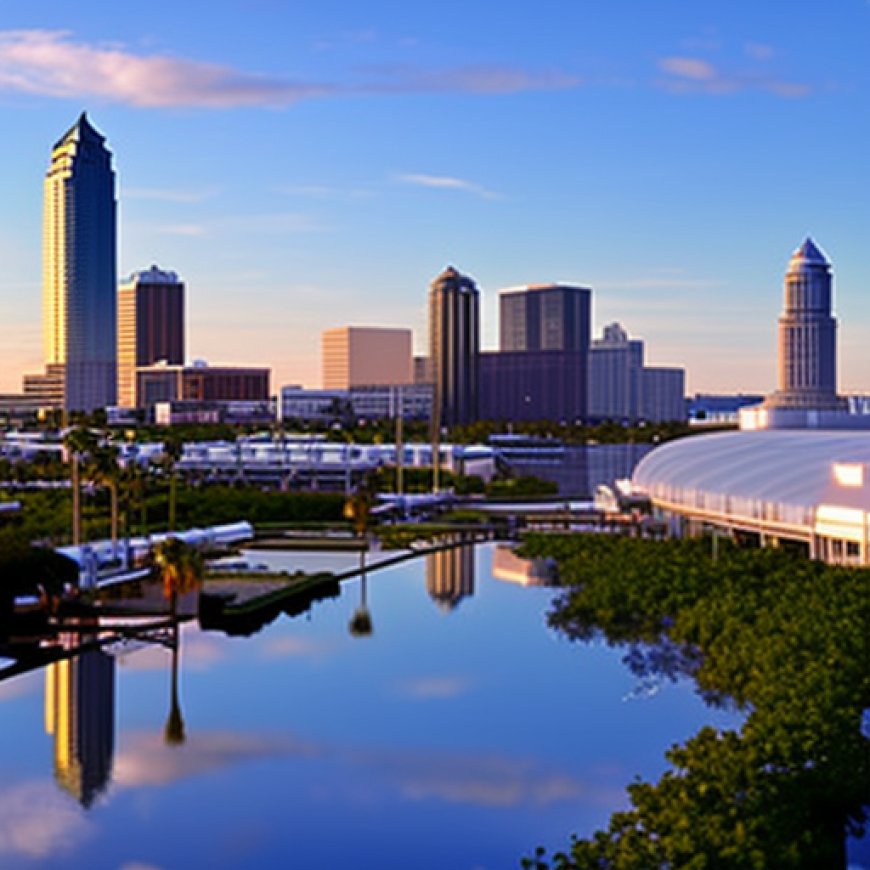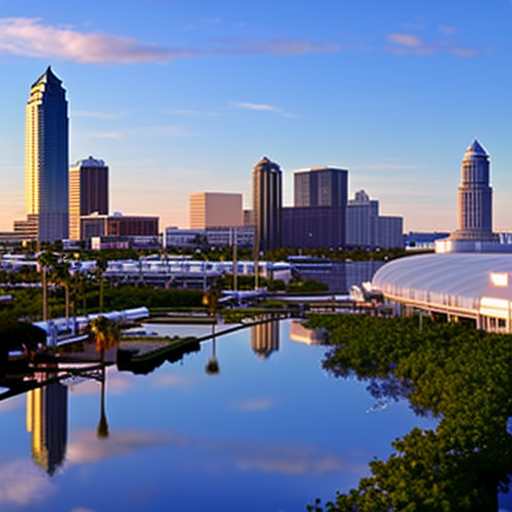Here’s a look at Tampa Bay’s reclaimed water, and the future of reuse
Here's a look at Tampa Bay's reclaimed water, and the future of reuse Tampa Bay Times


Tampa Bay’s Growing Population and the Need for Water
Tampa Bay is experiencing significant population growth, with estimates suggesting that by 2050, the region will see an increase of nearly 1.5 million people. This growth puts pressure on the area’s water supply, as all these new residents will require access to water.
Tampa Bay is fortunate to be surrounded by water, with drinking water sourced from rivers, groundwater wells, and desalinated sea water. However, reclaimed water has emerged as another resource that can help alleviate the strain on the drinking water supply.
Reclaimed water is highly treated wastewater that is commonly used by residents for irrigation purposes and by businesses for cooling equipment. While some see reclaimed water as a beneficial and cost-effective option to supplement the water supply, others have concerns about its use due to the “ick factor.”
Addressing these concerns, Mary Lusk, an assistant professor of soil and water sciences at the University of Florida, emphasizes the importance of reusing wastewater to conserve groundwater resources, aligning with the Sustainable Development Goals (SDGs).
Access to Reclaimed Water in Tampa Bay
Access to reclaimed water varies across the Tampa Bay region. Some areas have extensive access, while others have limited availability. Additionally, even in areas with access to reclaimed water, large quantities of treated wastewater go unused each day.
Local governments are now exploring different options for utilizing this excess water. Some possibilities include wetland renourishment, expanding access to reclaimed water, and even converting it into drinking water, which is considered innovative but controversial.
The Origins of Water Reuse in Tampa Bay
In the late 1970s and ’80s, Florida passed legislation to regulate wastewater discharge into Tampa Bay. Prior to this, untreated wastewater was released into the bay, causing harm to seagrass and water quality. In response, local governments made different choices regarding wastewater treatment.
For example, Tampa invested in advanced wastewater treatment plants that remove harmful bacteria, solids, and a significant portion of nitrogen. On the other hand, St. Petersburg focused on building an extensive reclaimed water system that meets high standards set by Florida’s Department of Environmental Protection.
Benefits and Challenges of Reclaimed Water
Reclaimed water provides both water supply and water quality benefits. It avoids releasing treated wastewater back into surface bodies of water and reduces the need for extracting drinking water for non-potable uses like irrigation.
However, reclaimed water does not meet drinking water standards and has its limitations. For example, in St. Petersburg, where permits for discharging treated wastewater are not available, reclaimed water is higher in nutrients like nitrogen. If not properly managed, reclaimed water can contribute to complications such as algal blooms.
Water experts emphasize the importance of using reclaimed water wisely and understanding its potential drawbacks while harnessing its benefits.
Disparities in Reclaimed Water Access
The availability of reclaimed water largely depends on factors such as cost and population growth. In newer communities like Wesley Chapel, where reclaimed water pipes were installed during construction, access to reclaimed water is more widespread. However, in older areas, the cost of installing new piping is often prohibitive.
Tampa faces similar challenges, with limited access to reclaimed water in certain areas. The city is focusing on understanding customer preferences and addressing concerns before expanding its reclaimed water system.
Managing Excess Wastewater
Regardless of customer usage, treated wastewater is processed daily at plants across the region. During Tampa Bay’s rainy season, the need for watering decreases, resulting in excess water. Local governments have implemented various strategies to manage this excess wastewater.
For example, Pasco County uses excess water for irrigation and wetland recharge, while Hillsborough County recharges a saltwater aquifer along the coast to prevent saltwater intrusion. In St. Petersburg, unused reclaimed water is injected deep underground into a saltwater aquifer.
However, some areas still discharge treated wastewater into surface water bodies, contributing to nitrogen levels that can lead to algal blooms. In 2021, a bill was passed requiring local governments to develop plans to stop this practice.
Options for Water Reuse
Under the 2021 legislation, cities and counties have several options for water reuse. Treated wastewater can be used to replenish wetlands, prevent saltwater intrusion, and even become drinking water.
While turning reclaimed water into potable water has been met with resistance in Tampa, other places like El Paso, Texas, have successfully implemented potable reuse programs. Plant City in Tampa Bay has completed a demonstration pilot for turning reclaimed water into drinking water and is considering larger-scale implementation.
Transparency and education have been crucial in gaining public acceptance for potable reuse projects. Funding remains a significant hurdle for implementing potable reuse systems, but the potential benefits make it a worthwhile investment.
SDGs, Targets, and Indicators
1. Sustainable Development Goal: SDG 6 – Clean Water and Sanitation
- Target 6.3: By 2030, improve water quality by reducing pollution, eliminating dumping and minimizing release of hazardous chemicals and materials, halving the proportion of untreated wastewater, and substantially increasing recycling and safe reuse globally.
- Indicator 6.3.1: Proportion of wastewater safely treated.
2. Sustainable Development Goal: SDG 11 – Sustainable Cities and Communities
- Target 11.5: By 2030, significantly reduce the number of deaths and the number of people affected and substantially decrease the direct economic losses relative to global gross domestic product caused by disasters, including water-related disasters, with a focus on protecting the poor and people in vulnerable situations.
- Indicator 11.5.1: Number of deaths, missing persons, and directly affected persons attributed to disasters per 100,000 population.
3. Sustainable Development Goal: SDG 12 – Responsible Consumption and Production
- Target 12.4: By 2020, achieve the environmentally sound management of chemicals and all wastes throughout their life cycle, in accordance with agreed international frameworks, and significantly reduce their release to air, water, and soil in order to minimize their adverse impacts on human health and the environment.
- Indicator 12.4.2: Hazardous waste generated per capita and proportion of hazardous waste treated, disaggregated by treatment method.
4. Sustainable Development Goal: SDG 15 – Life on Land
- Target 15.1: By 2020, ensure the conservation, restoration, and sustainable use of terrestrial and inland freshwater ecosystems and their services, in particular forests, wetlands, mountains, and drylands, in line with obligations under international agreements.
- Indicator 15.1.1: Forest area as a proportion of total land area.
Analysis
1. The issues highlighted in the article are connected to SDG 6 (Clean Water and Sanitation), SDG 11 (Sustainable Cities and Communities), SDG 12 (Responsible Consumption and Production), and SDG 15 (Life on Land).
2. Based on the article’s content, the specific targets that can be identified are:
– Target 6.3: Improve water quality by reducing pollution, eliminating dumping, and increasing safe reuse of wastewater.
– Target 11.5: Reduce the number of people affected by water-related disasters.
– Target 12.4: Achieve environmentally sound management of chemicals and wastes.
– Target 15.1: Ensure the conservation and sustainable use of terrestrial and freshwater ecosystems.
3. The indicators mentioned or implied in the article that can be used to measure progress towards the identified targets are:
– Indicator 6.3.1: Proportion of wastewater safely treated.
– Indicator 11.5.1: Number of people affected by water-related disasters.
– Indicator 12.4.2: Proportion of hazardous waste treated.
– Indicator 15.1.1: Forest area as a proportion of total land area.
Table: SDGs, Targets, and Indicators
| SDGs | Targets | Indicators |
|---|---|---|
| SDG 6 – Clean Water and Sanitation | Target 6.3: Improve water quality by reducing pollution, eliminating dumping, and increasing safe reuse of wastewater. | Indicator 6.3.1: Proportion of wastewater safely treated. |
| SDG 11 – Sustainable Cities and Communities | Target 11.5: Reduce the number of people affected by water-related disasters. | Indicator 11.5.1: Number of people affected by water-related disasters. |
| SDG 12 – Responsible Consumption and Production | Target 12.4: Achieve environmentally sound management of chemicals and wastes. | Indicator 12.4.2: Proportion of hazardous waste treated. |
| SDG 15 – Life on Land | Target 15.1: Ensure the conservation and sustainable use of terrestrial and freshwater ecosystems. | Indicator 15.1.1: Forest area as a proportion of total land area. |
Behold! This splendid article springs forth from the wellspring of knowledge, shaped by a wondrous proprietary AI technology that delved into a vast ocean of data, illuminating the path towards the Sustainable Development Goals. Remember that all rights are reserved by SDG Investors LLC, empowering us to champion progress together.
Source: tampabay.com

Join us, as fellow seekers of change, on a transformative journey at https://sdgtalks.ai/welcome, where you can become a member and actively contribute to shaping a brighter future.







